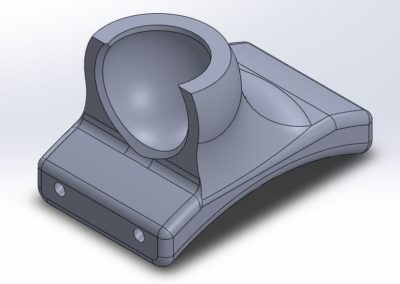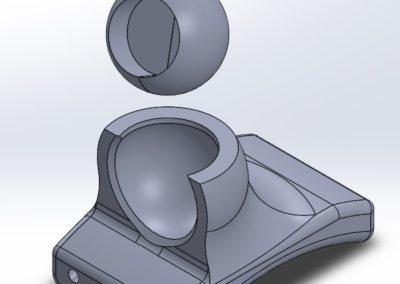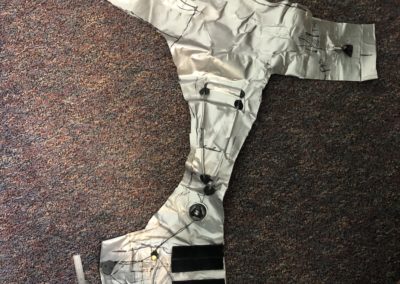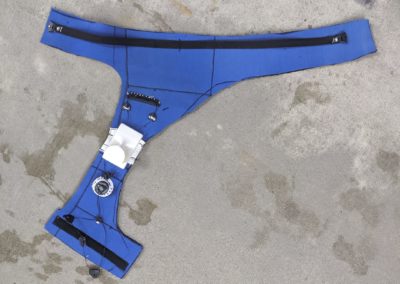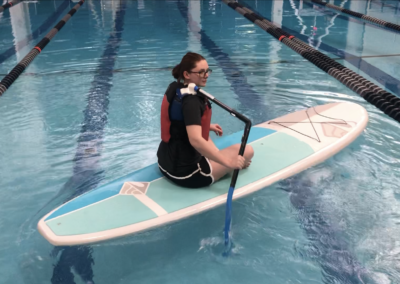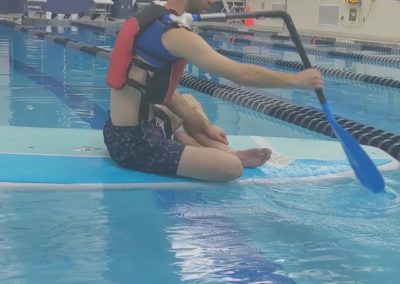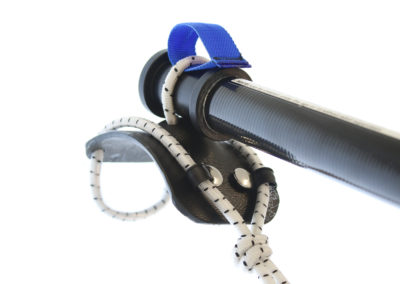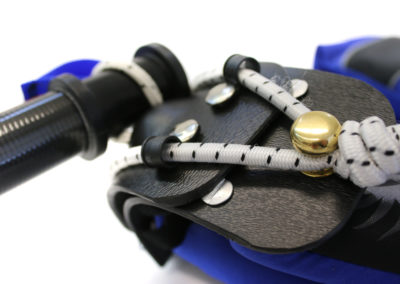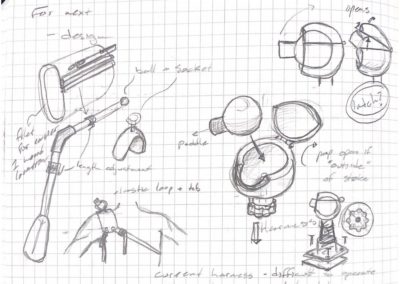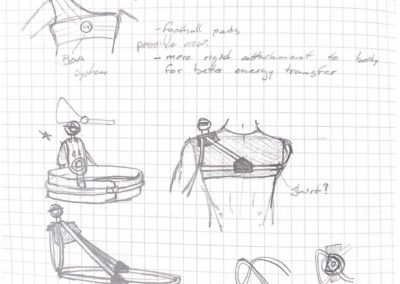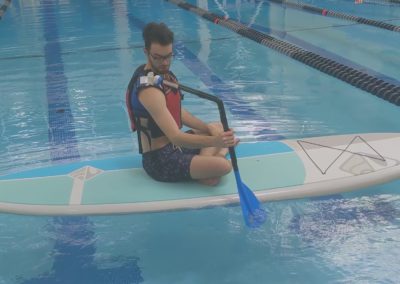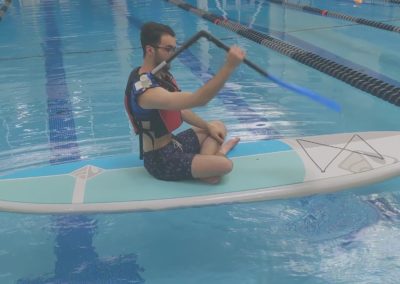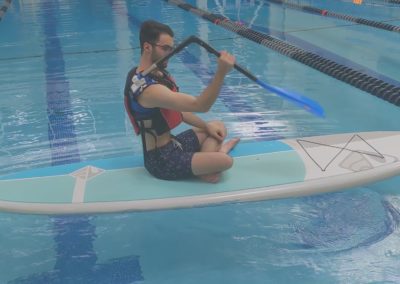One Arm Freedom Canoe Paddle
Overview
The One Arm Freedom paddle was invented by Cindy Dillenshnieder in order to allow those with upper extremity amputations or limited motion to be able to participate in paddle sports like canoeing or dragon boat racing. The current designs utilize a shock cord loop to hold a specially designed paddle to a shoulder saddle [1]. The saddle then attaches to the user’s personal flotation device (PFD), acting as the second hand on the paddle. While functional, the design has its shortfalls. With enough force, the paddle can slip out of the shock cord, endangering the user to head injury in addition to being difficult to reset with one hand. Attaching to the user’s PFD at the shoulder results in a large amount of slop at the joint. Additionally, the harness of this design is difficult to put on and remove without assistance.

Figure 1: Current design of One Arm Freedom paddle.
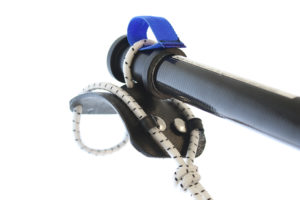
Figure 2: Current design of One Arm Freedom paddle.
The primary goal of this project is to improve on the design of the One Arm Freedom canoe paddle in order to decrease the amount of energy lost to motion in the PFD. The new device will securely attach to the user’s torso and attach to the paddle in a way that emulates the range of motion of a two-handed paddler. The design must also be able to be attached one-handed, and without assistance. The design must also allow for the use of a Type III PFD without modification, and the paddle must quickly release from the user in an emergency/bail out situation. The device should be produced for a similar cost to the original design, allowing it to be sold for at the same price point or lower.
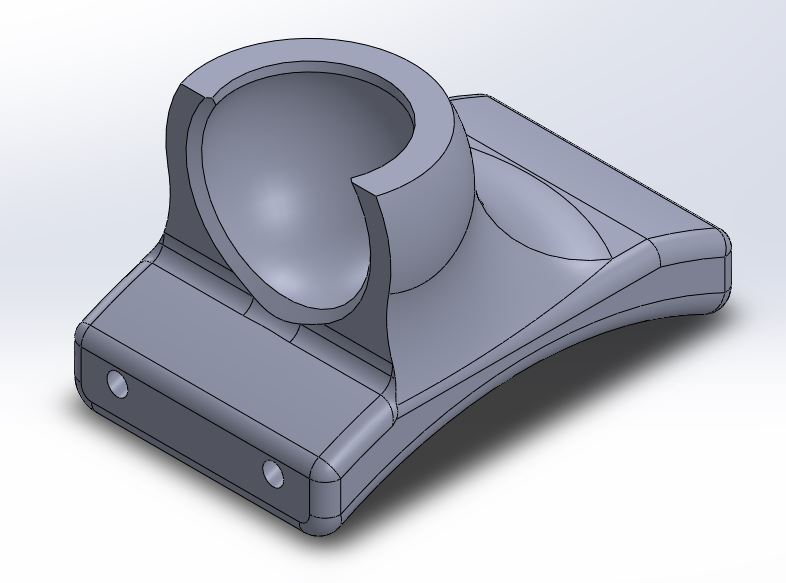
Gallery contains all images from webpage to provide larger views.
Team Members
- Hayden Martinez
- Jasmine Berry
The Client
- Adaptive Adventures
- Dillenschneider Designs, LLC
Acknowledgements
Project Advisors: Dr. Joel Bach, Dr. Chelsea Salinas
Donations Made by: Adaptive Adventures
Our team would like to thank Chris Weigand and Adaptive Adventures for bringing this project to the Human Centered Design Studio, Cindy Dillenschneider for allowing us to work on her design, as well as Dr. Joel Bach and Dr. Chelsea Salinas for their invaluable assistance, expertise, and guidance. The team would also like to thank all the studio members for their interest and suggestions for progressing our project.
Video
Elevator Pitch
Our design team was approached by Adaptive Adventures, a company with a mission to provide progressive outdoor sports opportunities for children, adults and veterans with physical disabilities as well as their families [2]. Adaptive Adventures requested a re-design of the One-arm Freedom paddle available from Dillenschnieder designs. With the blessing of the original designer, the team started work on the project.
We were tasked with improving the energy transfer from the shoulder to the paddle, but we knew we could do more with this design. We took user feedback of the current design and sought to improve the user comfort and functionality of this product. Energy transfer in the original design was inhibited by the shoulder joint, the bungee system not only required greater force than a traditional shoulder joint might, but had a dangerous potential to slip loose and cause harm to the users face. The redesign utilized a ball and socket joint to mimic the movement of a shoulder, this decreased the force required to paddle, and secured the joint so that it would not slip loose and harm the user. An adapter was also created so that older versions of the product can be used with the new jointing system.
The new design also supports a quick release function, by raising the paddle upwards, the ball is removed from the joint, this is useful for both user convenience, as well as emergency situations. The original harness had thin straps that caused discomfort for the user, additionally, the complicated harness system was exceedingly difficult to put on one-handed. The team decided that a thick neoprene harness would increase comfort, and the new design can be placed and tightly secured using only one hand. Our redesign has the adaptive sports community excited, and with further refinement this device could someday make an appearance in the Paralympic Games.
Design Approach
From the start it was clear that attaching the paddle to the PFD was not sufficient for sporting applications. The new design would need to attach securely to the user while still releasing in an emergency. The initial concept presented by our client, Chris Weigand, was a ball and socket joint to provide the necessary motion for the device. In order to more securely attach the socket of the joint to the user, our team envisioned a harness worn beneath the PFD, that did not require modification, that would tighten around the user’s rib cage and shoulder to provide a more secure fit. The harness prototyping began as duct tape and string to determine dimensions and geometry. The duct tape allowed us to fit the harness “blank” to a human torso and add/ remove material as necessary. One important extension to the harness were wings for Velcro strips. These strips allow the harness to be placed into position on the body one-handed before securing and tightening the string system.
Once we had an initial design for the size, shape, and basic functionality of the harness, we translated the duct tape shape to neoprene, cut from a recycled wet-suit. The string was replaced by a BOA system to tighten the harness. The BOA system utilizes circular ratchet to tighten and a wire cord with plastic pieces to change the direction of tension sewn onto the neoprene. The BOA knob was placed on the chest near the shoulder so as not to interfere with the PFD, and to remain accessible to the user.
The shoulder joint was designed to allow for 3D printing in order to lower costs while still producing complex geometry. Initial ball and socket models were designed and printed to gauge print tolerances and serve as a proof of concept. This design also featured a ‘cap’ to the socket but was abandoned due to structural weaknesses that were found regardless of print orientation. The next iteration was able to integrate the existing paddle into our socket by printing two hemispheres with voids to match the paddle profile, mating to form the shoulder ball. A base was added to the socket so that it could sit on top of the shoulder, and tunnels were added in the base for the BOA cording to pass though. Several prints were completed in order to find the optimal printing orientation for the design in order to maximize functional strength. The BOA tubes proved insufficient for holding the socket in place, so some rubber sheeting was placed between the printed part and the harness to increase friction and cut down on the sliding motion.

Figure 3: Duct tape prototype, with BOA system.
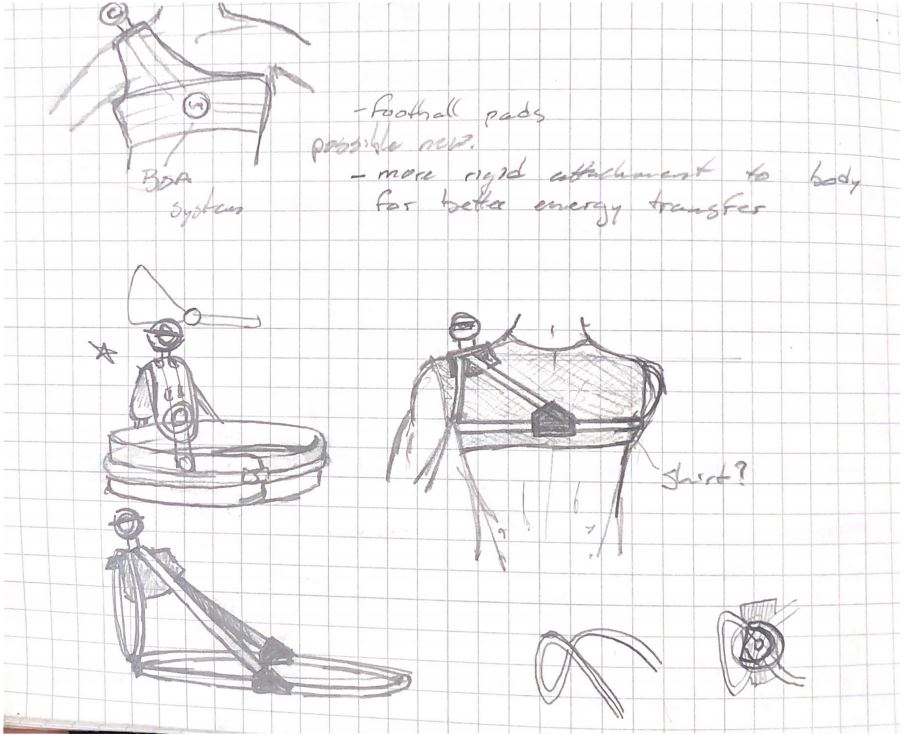
Figure 4: Initial Harness Sketches.
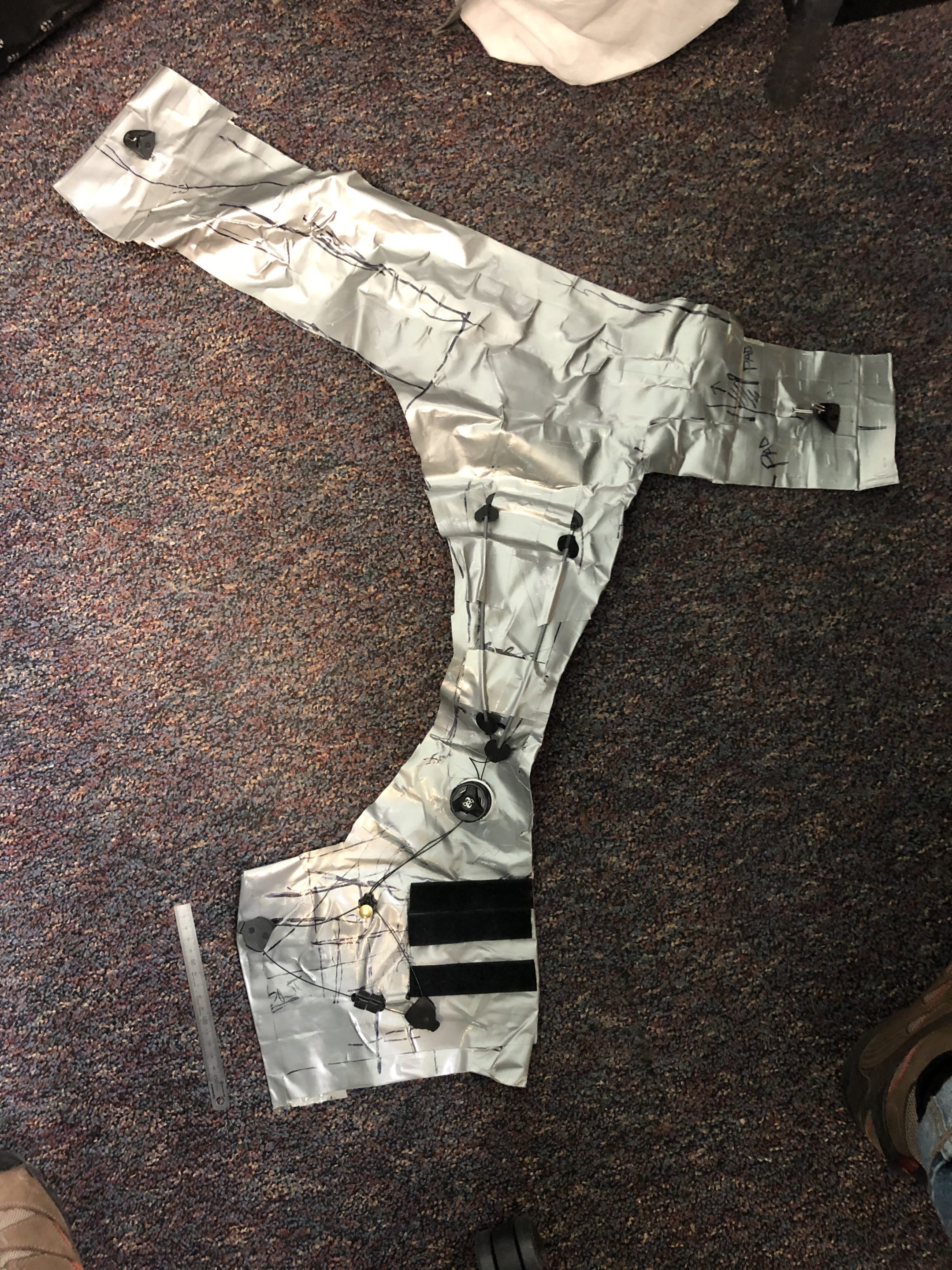
Figure 5: Duct tape prototype, full view.
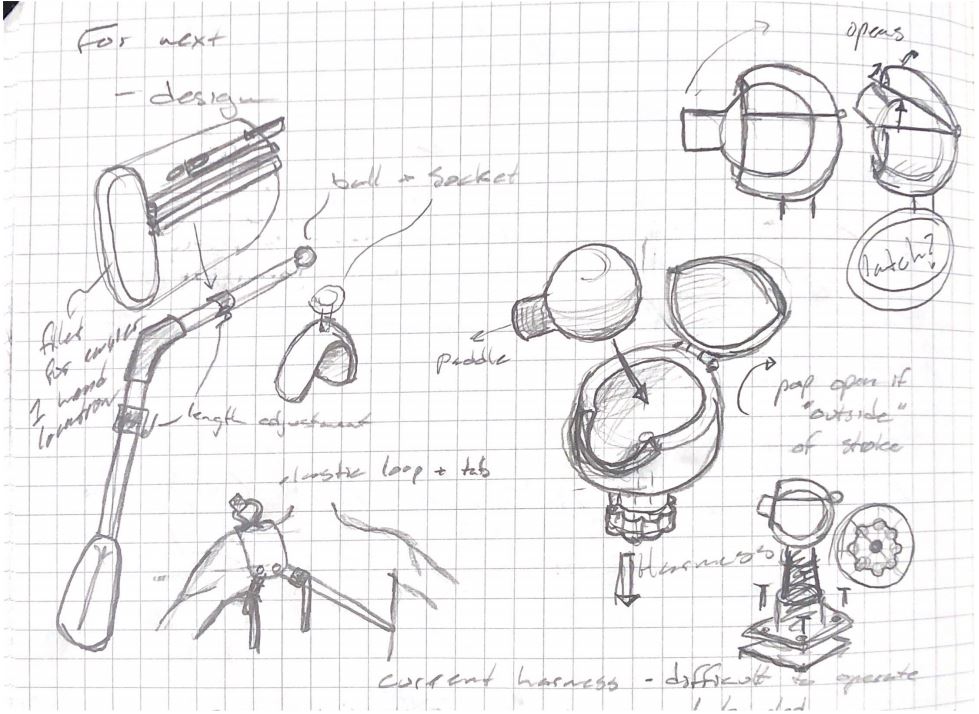
Figure 6: Initial joint sketches.

Figure 7: Early joint prints.
Design Solution
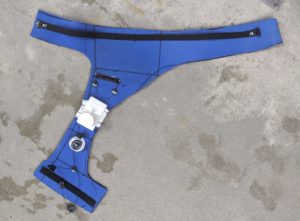
Figure 8: Neoprene prototype with BOA system.
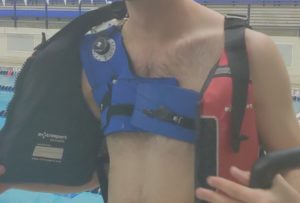
Figure 9: Harness is worn beneath the PFD.
The harness designed by the team functions well. The neoprene base with Velcro wings keeps the harness in place while the BOA clips are fastened, and the system is tightened. The path the cord follows tightens the harness around the chest and shoulder when the BOA knob is depressed and turned. With the type III PFD our team was given by Adaptive Adventures, the shoulder socket on the harness was able to comfortably sit next to the straps. The harness hardware was low profile enough to be comfortable beneath the PFD with the cushioning from the neoprene.
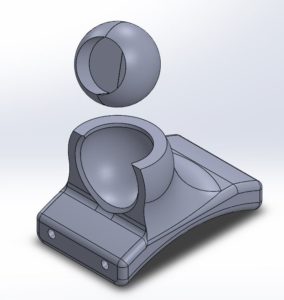
Figure 10: Shoulder cup, with adapter ball for current paddle.
When testing this iteration in the CSM Recreation Center pool, we found that the paddle easily releases from the socket in unintended positions of the stroke. However, the testing did prove that the paddle ball could be easily inserted into the shoulder socket using one hand and that the paddle could be easily removed from the harness in a “bail out” scenario. Physical testing also proved that the harness could be secured one handed in most scenarios, and that outside assistance is not likely to be required for full use of the product.
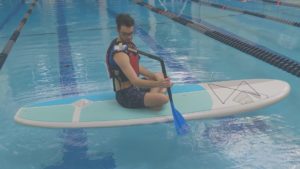
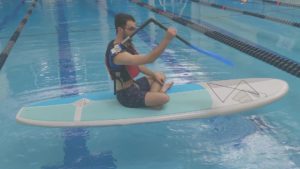
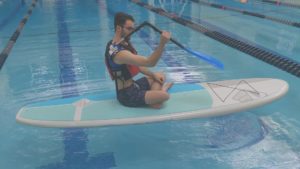
Figures 11-13: Placing paddle into shoulder cut one-handed.
Next Steps
In its current state the new design of the One Arm Freedom paddle is still a little loose at the shoulder and releases in unintended locations throughout the stroke. Future work can benefit from refining the dimensions on the ball and socket joint to improve the functional range of motion, as well as help with inserting the ball into the socket. The cap idea that was explored briefly may help keep the paddle in the socket during the stroke and could be explored further. Additionally, the socket may need to be reoriented on the base to improve range of motion. The rear BOA channel is pulled towards the shoulder and can possibly be attached to the webbing strap to reduce neoprene stretching. Stretching, motion of any kind really, within the harness should also be addressed in future work. In other words, the design is functional but needs polishing before it is ready for public use.
Meet the Team
Hayden Martinez
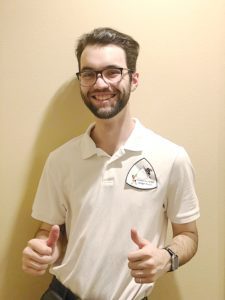 Hayden Martinez is a Senior in the Mechanical Engineering department. Born and raised all over Colorado, the School of Mines Runs through Hayden’s blood. The fourth of five family members to attend, Golden is like a second home to him. This project was an excellent application of some of his favorite skills, including; hands-on problem solving, 3D Printing, CAD modeling, and iterative design. Being a member of the Human Centered Design Studio has allowed him to achieve a long held goal of working with prosthetics and adaptive technologies.
Hayden Martinez is a Senior in the Mechanical Engineering department. Born and raised all over Colorado, the School of Mines Runs through Hayden’s blood. The fourth of five family members to attend, Golden is like a second home to him. This project was an excellent application of some of his favorite skills, including; hands-on problem solving, 3D Printing, CAD modeling, and iterative design. Being a member of the Human Centered Design Studio has allowed him to achieve a long held goal of working with prosthetics and adaptive technologies.
Jasmine Berry
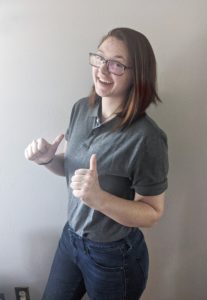 Jasmine Berry is a senior in mechanical design, originally from Elizabeth, CO. An avid camper, and view enthusiast, she enjoys the proximity of the mountains to Mines. This project reinforced the desire to use engineering to help people with disabilities, specifically amputees, that made Jasmine originally want to pursue engineering.
Jasmine Berry is a senior in mechanical design, originally from Elizabeth, CO. An avid camper, and view enthusiast, she enjoys the proximity of the mountains to Mines. This project reinforced the desire to use engineering to help people with disabilities, specifically amputees, that made Jasmine originally want to pursue engineering.
Bibliography
[1] “Product Information”. Dillenschneider Designs. [Online]. Available: https://dillenschneiderdesigns.com/product-information/
[2] “About Us”. Adaptive Adventures. [Online] Available: https://adaptiveadventures.org/
